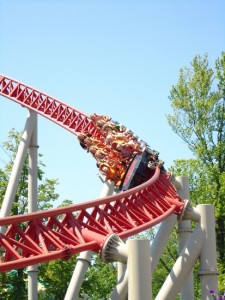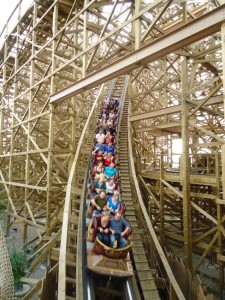Theme park enthusiasts like to get footage of their favourite rides not just from a distance but whilst on board. Many like to take point of view (POV) films whilst riding, often using devices like GoPro or Contour helmet cameras which are small, lightweight and can be secured to the person. Some riders even just hold their cameras for the duration of the circuit. Whilst this footage is of interest to other enthusiasts, most parks forbid the use of cameras on the rides leaving guests trying to sneak them on. Is this policy fair or should people be allowed to film their experience?
Camera Policy
Whilst banning cameras may seem a bit draconian, having worked at a theme park for several years, I understand why such a policy is necessary. The main reason cameras are problematic is that they present a hazard to other guests and the staff on the ride. Guests who hold their cameras have a tendency to drop them and even helmet cams and similar devices secured to the person get dislodged due to the forces on many thrill rides. If the cameras do break loose they can fly back hitting the passengers behind or strike guests in the queue line. I have lost count of the number of times I was hit by cameras and mobile phones flying off of rides. They turn into dangerous high speed projectiles and it hurts!
Ride Operation
The dangers of flying cameras may be quite obvious but there are other issues which may not occur to guests. Objects falling off rides can cause an obstruction on the track or can land in front of the sensors on the ride causing a fault to show on the computer system. When this happens the ride will generally emergency stop itself causing a delay in operation whilst the staff try to deduce what has tripped the system. Then everyone in the queue gets to wait longer. I once had to close a roller coaster for nearly an hour whilst trying to find out what had caused the system to show a fault. It turned out to be a blocked sensor caused by a tobacco tin falling out of a guest’s pocket. Filming a thrill ride can also lead to passengers losing concentration and failing to brace themselves at certain points of the ride. This can lead to severe discomfort and even injury.
Lost Property
Another major reason for the ban on cameras is the difficulty in retrieving them when they become separated from their owners. Thrill rides and Roller Coasters cover huge areas and are very fast moving, dangerous pieces of machinery. In order to find a lost camera it is necessary for the ride’s staff to shut down the ride before they enter ride areas near the track. It is crucial to prevent any chance of the machine being operated whilst they are in the danger zones. They then have to go on a major mission around the ride to find the missing camera, hunting through bushes, track work and landscaping in the hope of finding it. As such a search causes a shutdown to the ride this procedure is usually not carried out until after the park closes delaying the time at which the staff can go home. Many items are never found or are damaged beyond repair.
Bad Idea
Getting footage of a ride is great fun but unfortunately presents too many dangers to be permitted. It is best to keep the helmet cameras safely in a locker whilst riding and to leave the recording of the ride experience to the staff who can film the rides when there is no one about to get hurt.
Byline
Article by Sally Stacey who operated several rides at a UK Theme park


